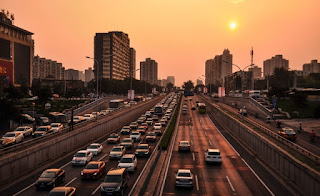Article discussing issues, assumptions, entitlement and habits round the use of motor cars or vehicles in urban areas in America, same issues exist in Australia. Often if not always accidents, injuries, deaths, more roads, car parks, traffic congestion, bitumen or asphalt, fossil fuels and pollution are never questioned or linked to car usage. However, if question do arise about pollution, traffic congestion etc. the deflection used is blaming ‘immigration’ or ‘population growth' rather than focus upon the incentives e.g. salary package tax breaks and lack of disincentives e.g. discouraging private motor vehicle usage.
From The Week: 'American cities need to phase out cars
Ryan Cooper
August 19, 2019
On August 12, a man named Umar Baig was driving illegally in Brooklyn — speeding his Dodge Charger down Coney Island Avenue far, far above the speed limit of 25 miles per hour. At the intersection with Avenue L, he ran a red light, and smashed directly into the side of a Honda SUV.
The collision was so violent that Baig's car lifted the Honda completely off the ground for a split second in the process of flinging it at high speed across the oncoming lanes of Coney Island Avenue — where the SUV crushed a cyclist named Jose Alzorriz, who had just pulled up to wait for the red light Baig blew through. Bystanders lifted the car off him, but Alzorriz later died of his injuries. (A pedestrian and the Honda's driver were also injured, but not fatally).
This was the 19th cyclist killed by a car in New York City so far in 2019, in addition to 69 pedestrians — as compared to 10 and 107 respectively in the whole of 2018. For reasons of safety and basic urban functionality, it's time to start banning private automobiles from America's urban cores.
The basic problem with cars in a dense urban setting like New York is that they go too fast and take up too much space. Dense cities are enormously more energy efficient than sprawling suburbs or exurbs because apartment buildings and row houses are far more efficient to heat and cool than single-family homes (due to shared walls), larger enterprises can take advantage of efficiencies of scale, and because lots of people packed into a small area enables highly-efficient mass transit. New Yorkers emit only about 2.3 tons of carbon dioxide per person, as compared to 45 tons from residents of Flagstaff, Arizona.
A car-centered transportation system is simply at odds with the logic of a dense city. For commuters, cars take up a huge volume of space being parked at home and at work. On the road, a lane of highway traffic can transport about 3,000 people per hour under perfect conditions, while a subway can easily manage 10 times that — and many do even better. And while subways can be delayed, conditions are rarely ideal on the highway — on the contrary, every day at rush hour most are jammed to a crawl with too many cars, or slowed by some gruesome accident.
What's more, the terrible toll of injuries and deaths inflicted on New York's cyclists and pedestrians this year is simply what happens when one allows cars to roam free in cities. It is highly risky to allow huge, heavy steel cages capable of high speeds to be flying around crowds of delicate human bodies. It takes only a slight error or moment of inattention to get someone brutally killed.
Yet America's urban centers were still rent asunder during its great mid-20th century car bender. Large swathes of our finest cities were eviscerated to make way for filthy, dangerous freeways, and hideous parking lots and garages. New cities were built entirely around this new transport paradigm, eating up vast quantities of land and forcing millions upon millions of people to spend hours every day stuck in traffic. Cars became a near requirement for most Americans, even in relatively dense metros.
This has left many American cities and neighborhoods without high-quality public transit, even where density is high enough that it could be supported. Big chunks of D.C., Philadelphia, New York, and many other places are stuck in a sort of no-man's-land where bus and train service aren't good enough to enable a truly car-free lifestyle for most residents — but driving and parking are still a monumental inconvenience.
All this is why American cities should follow the lead of European cities like Oslo and Brussels, and start phasing out private cars in their central cities…..
…..All this would be expensive and difficult in many cities, but the bigger obstacle is cultural. Even in New York, the only city in America where a majority of households do not own a car, laws are so ludicrously biased in favor of drivers that police and prosecutors are struggling to find a way to charge Umar Baig with a serious crime. A proposal to ban private vehicles from just a few blocks of the clogged 14th Street in lower Manhattan to improve bus service inspired screaming outrage from the reactionary New York Post, and has been repeatedly blocked by a judge. But perhaps once the manifest benefits of a car-free urban core can be widely seen, attitudes will start slowly shifting. Cars simply do not belong downtown.'
For more articles and blogs about Australian politics, Immigration and Population Growth click through.
 |
| Cars, Roads and Fossil Fuels (Image copyright Pexels) |
From The Week: 'American cities need to phase out cars
Ryan Cooper
August 19, 2019
On August 12, a man named Umar Baig was driving illegally in Brooklyn — speeding his Dodge Charger down Coney Island Avenue far, far above the speed limit of 25 miles per hour. At the intersection with Avenue L, he ran a red light, and smashed directly into the side of a Honda SUV.
The collision was so violent that Baig's car lifted the Honda completely off the ground for a split second in the process of flinging it at high speed across the oncoming lanes of Coney Island Avenue — where the SUV crushed a cyclist named Jose Alzorriz, who had just pulled up to wait for the red light Baig blew through. Bystanders lifted the car off him, but Alzorriz later died of his injuries. (A pedestrian and the Honda's driver were also injured, but not fatally).
This was the 19th cyclist killed by a car in New York City so far in 2019, in addition to 69 pedestrians — as compared to 10 and 107 respectively in the whole of 2018. For reasons of safety and basic urban functionality, it's time to start banning private automobiles from America's urban cores.
The basic problem with cars in a dense urban setting like New York is that they go too fast and take up too much space. Dense cities are enormously more energy efficient than sprawling suburbs or exurbs because apartment buildings and row houses are far more efficient to heat and cool than single-family homes (due to shared walls), larger enterprises can take advantage of efficiencies of scale, and because lots of people packed into a small area enables highly-efficient mass transit. New Yorkers emit only about 2.3 tons of carbon dioxide per person, as compared to 45 tons from residents of Flagstaff, Arizona.
A car-centered transportation system is simply at odds with the logic of a dense city. For commuters, cars take up a huge volume of space being parked at home and at work. On the road, a lane of highway traffic can transport about 3,000 people per hour under perfect conditions, while a subway can easily manage 10 times that — and many do even better. And while subways can be delayed, conditions are rarely ideal on the highway — on the contrary, every day at rush hour most are jammed to a crawl with too many cars, or slowed by some gruesome accident.
What's more, the terrible toll of injuries and deaths inflicted on New York's cyclists and pedestrians this year is simply what happens when one allows cars to roam free in cities. It is highly risky to allow huge, heavy steel cages capable of high speeds to be flying around crowds of delicate human bodies. It takes only a slight error or moment of inattention to get someone brutally killed.
Yet America's urban centers were still rent asunder during its great mid-20th century car bender. Large swathes of our finest cities were eviscerated to make way for filthy, dangerous freeways, and hideous parking lots and garages. New cities were built entirely around this new transport paradigm, eating up vast quantities of land and forcing millions upon millions of people to spend hours every day stuck in traffic. Cars became a near requirement for most Americans, even in relatively dense metros.
This has left many American cities and neighborhoods without high-quality public transit, even where density is high enough that it could be supported. Big chunks of D.C., Philadelphia, New York, and many other places are stuck in a sort of no-man's-land where bus and train service aren't good enough to enable a truly car-free lifestyle for most residents — but driving and parking are still a monumental inconvenience.
All this is why American cities should follow the lead of European cities like Oslo and Brussels, and start phasing out private cars in their central cities…..
…..All this would be expensive and difficult in many cities, but the bigger obstacle is cultural. Even in New York, the only city in America where a majority of households do not own a car, laws are so ludicrously biased in favor of drivers that police and prosecutors are struggling to find a way to charge Umar Baig with a serious crime. A proposal to ban private vehicles from just a few blocks of the clogged 14th Street in lower Manhattan to improve bus service inspired screaming outrage from the reactionary New York Post, and has been repeatedly blocked by a judge. But perhaps once the manifest benefits of a car-free urban core can be widely seen, attitudes will start slowly shifting. Cars simply do not belong downtown.'
For more articles and blogs about Australian politics, Immigration and Population Growth click through.
